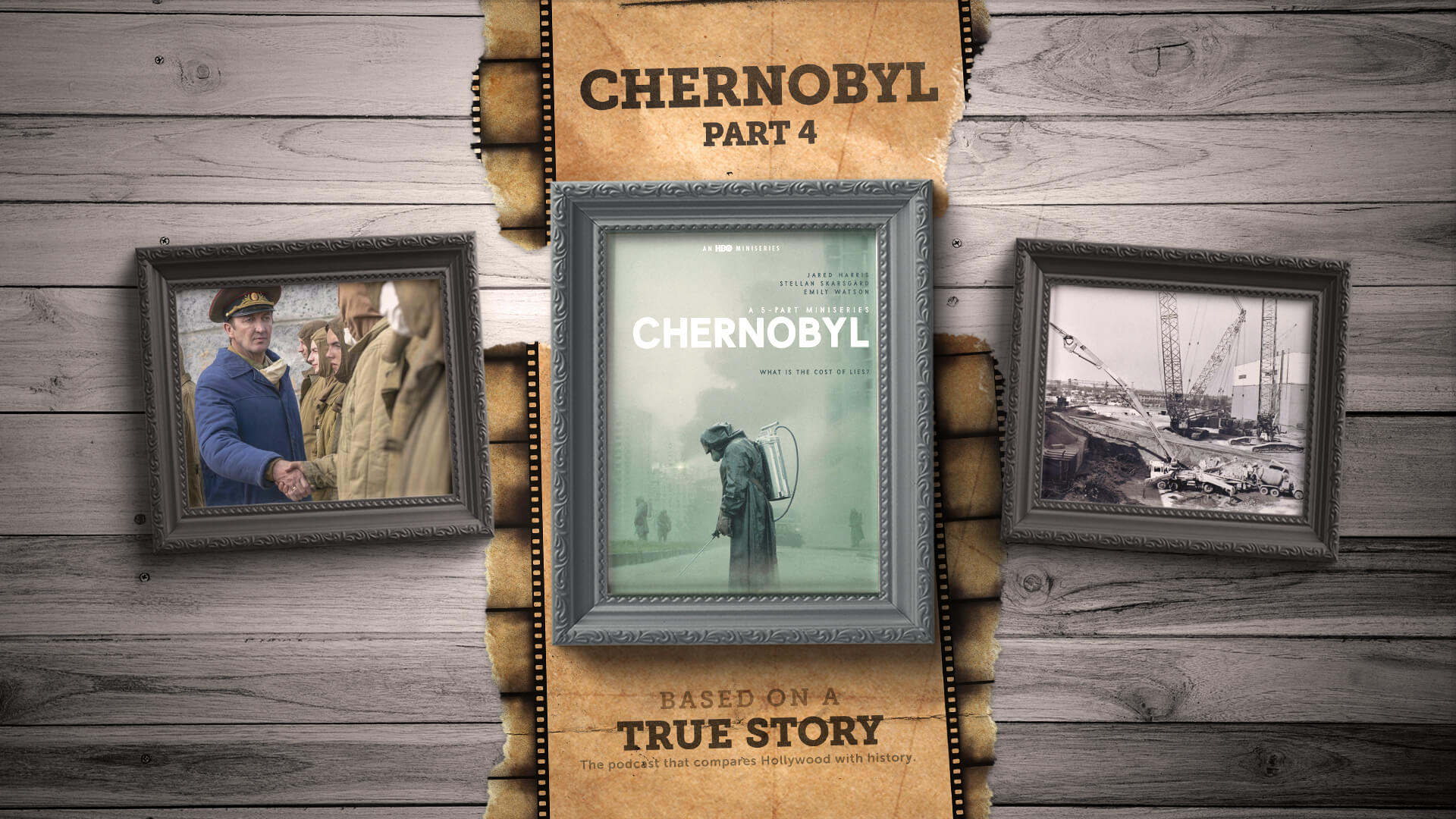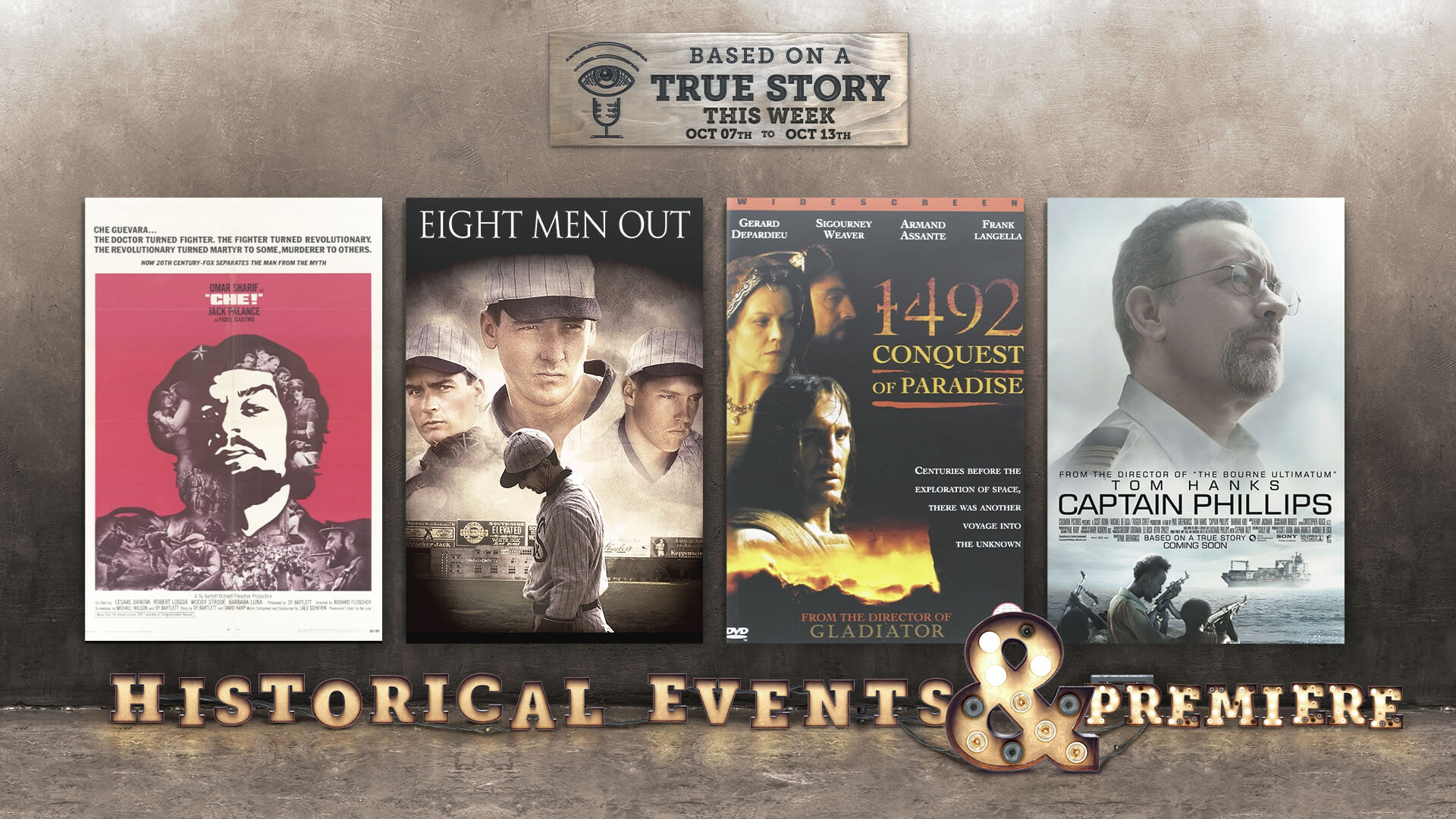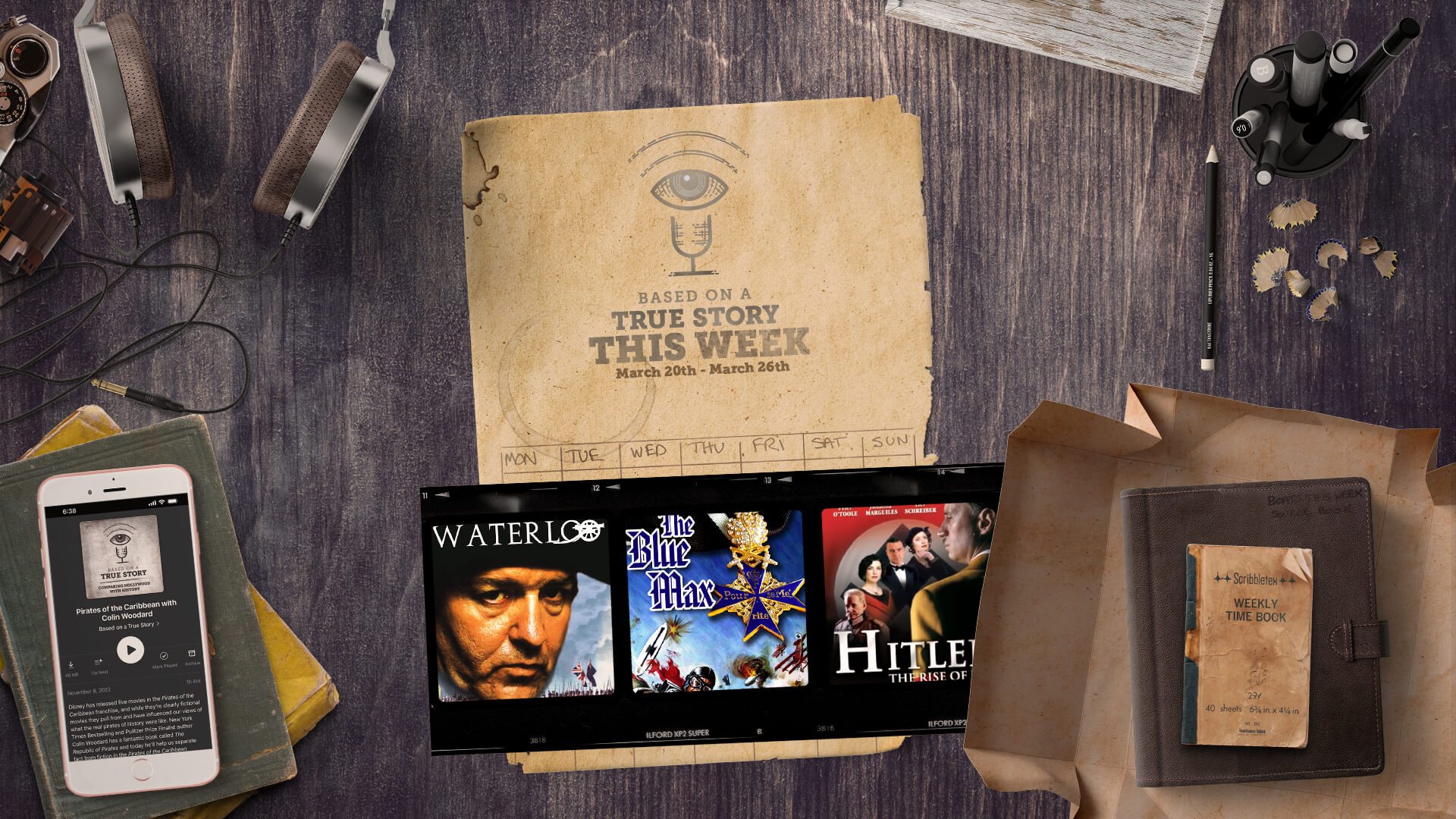In this episode, we’ll learn about historical events that happened this week in history as they were depicted in Lizzie, The Hobbit, and They Died with Their Boots On.
Did you enjoy this episode? Help support the next one!
Disclaimer: Dan LeFebvre and/or Based on a True Story may earn commissions from qualifying purchases through our links on this page.
Transcript
Note: This transcript is automatically generated. There will be mistakes, so please don’t use them for quotes. It is provided for reference use to find things better in the audio.
June 20, 1893. Massachusetts.
A lone man stands on top of a roof while some birds fly overhead. It’s a peaceful scene. He seems to be wearing a uniform of some kind as he watches the birds flying. The camera then cuts to inside and we can assume this is inside the building the man was on. It’s a dark room, lit only by a candle. A woman is inside, sitting in silence.
The noise of metal doors banging can be heard in the background. This seems to be a prison or jail of some sort.
We’re only with her for a moment before going back outside, though, as the camera cuts to a beautiful blue sky with big white, puffy clouds. The sun is shining through the clouds.
This scene only lasts for a few seconds, too, as now we can see the same woman who was in the dark cell is outside now. Her eyes are closed as she seems to be soaking up the sun on her face.
Then, the movie cuts to black.
That is how the 2018 movie called Lizzie comes to an end, and although the movie doesn’t give us any indication of timeline, we can assume that those two scenes are on either end of this week in history because it was on June 20th, 1893, that Lizzie Borden was acquitted of the axe murders of her father and stepmother in Fall River, Massachusetts.
And since we see Lizzie in her cell, and then free, that’s why I’m assuming we’re seeing the moments just around the trial itself.
Lizzie’s trial was for the murders of her father and stepmother. And while that happened almost a year earlier, so not this week in history, to understand the trial we have to understand the events that happened that day.
To be honest, we probably will never know the full story.
But what we do know is that Lizzie Borden’s father, Andrew, was 69 years old and her stepmother, Abby, was 64. Lizzie herself was 32. The Bordens were a well-off family who, despite having money, lived a rather frugal lifestyle.
On the morning of August 4th, 1892, Andrew was napping on the couch. Upstairs in the house, Abby was cleaning. Bridget, the family’s maid, wasn’t feeling well so she was in her room. Lizzie said she was in the barn looking for irons, or those lead sinkers you put on a fishing line, because they were planning to go fishing. After looking for those, she came inside to find her father lying dead on the couch.
At 11:30 AM, Bridget said she heard Lizzie’s screams after discovering the body. Andrew’s face was unrecognizable as he had been hit 11 times with a hatchet. A little while later, they found Abby’s body upstairs. She had been hit 18 or 19 times with the hatchet.
When investigators showed up soon after, Andrew’s body was still warm while Abby’s was already cold, they determined the two murders happened at least an hour and a half apart. Initially, the police thought a male “foreigner” committed the crime. They found a hatchet at a nearby farm with blood on it. But it turns out that hatchet was used to kill chickens, so that’s what that blood was. Another man was seen nearby, but he had a good alibi for the time of the murders.
Lizzie had said she was in the barn eating pears in the loft.
Wait. I thought her reason for being in the barn was to look for irons. Her story changed. That’s odd. But, she didn’t have any blood on her and killing someone with a hatchet would be covered in blood. Looking into it more, perhaps she burned a dress in a stove. Maybe that had the blood? Lizzie claimed she burned it because it was stained with paint. And the day before she had tried to buy a poison? She wasn’t actually able to purchase it, but that seemed suspicious.
The questions started to add up, and about a week later, Lizzie was arrested. She made a “Not Guilty” plea and for almost a year, Lizzie was in jail as the case as well as a jury was put together. That’s the part of the movie we heard depicted at the start of this segment.
So, that was in August of 1892.
Lizzie’s trial started on June 5th, 1893. Her defense team, which included a former governor of Massachusetts, started poking holes in the prosecution’s case. Lizzie was well-liked. She was a churchgoer. She had fainted in the courtroom right before the jury’s eyes when they brought her parent’s skulls into the courtroom as evidence.
On June 20th, it was time for the jury to consider what they’d heard over the past few weeks. Women weren’t allowed to be on juries at that time, so the jury in this case consisted of 12 men. They adjourned and an hour later came back with the verdict that Lizzie Borden was acquitted.
The final sequence leading up to seeing Lizzie Borden being freed that we described for this week in history started at about an hour and 38 minutes into the 2018 movie Lizzie.
June 22, 1342. Middle-earth.
There are mountains in the background against blue skies with trees and rocks scattered among the green grass in the foreground.
The camera cuts to another beautiful landscape, this time most of the grass is yellow but there are still scattered trees and bushes here and there among the rolling hills. The focus of this landscape are the pretty purple flowers, some most obvious in the foreground of the camera. The only movement we can see are two horses in the middle of the frame. Or maybe it’s a horse and a pony, as the shot continues we can see one is larger than the other.
In the next shot, the same two riders are in a new landscape now. No more purple flowers, but an almost neon green grass covers the terrain. The big boulders stand out in even more contrast against the green. A peaceful stream is in the foreground, along with what looks to be some cows grazing nearby.
There’s another cut and now we’re in some woods. Tall trees with thick trunks. The two riders aren’t on their horses anymore as they walk toward the camera, laughing as they do. The taller one, wearing a grey cloak and hat, tells the shorter one that this is the border of the Shire—and here is where they’ll split up.
After saying a few words of farewell, Martin Freeman’s version of Bilbo Baggins tells Ian McKellen’s version of Gandalf that he doesn’t have to worry about the ring because he lost it.
Then, in the next shot, we see Bilbo walking along the road carrying his things. Among the rolling green hills, round doors can be found. Some others pass him carrying a heavy box. Bilbo takes a second glance—wait a minute, that’s my mother’s glory box.
Still more of Bilbo’s things are being carried away from his home. It seems he’s arrived home just in time as they’re selling off his things!
As you’ve probably figured out by now, this comes from the 2014 movie The Hobbit: The Battle of the Five Armies, and it’s depicting something that happened this week when Bilbo Baggins returned to his home at Bag End on June 22nd, 1342.
Well, at least, it would’ve happened this week in history if The Lord of the Rings were based on a true story. Haha! But, I couldn’t resist to include this because the date of June 22nd, 1342, by the Shire Reckoning calendar, was mentioned quite clearly in the writings of J.R.R. Tolkien.
According to Tolkien’s writing, the movie was correct to show that when Bilbo returned home he found his neighboring hobbits to be auctioning off all of Bilbo’s things. His home, called Bag End, was something his own relatives wanted for their own, so when he didn’t return for so long they assumed he was dead.
His return home on June 22nd stopped all this, and he was able to prove who he was by showing them the contract he signed with the dwarves for the adventure.
And while the story may be fictional, that doesn’t mean there isn’t some real history in there. For example, the name of Bilbo’s home of Bag End came from Tolkien’s aunt who lived in a farmhouse they called Bag End. He also described the home as being on a dead-end street. Or, in other words, a cul-de-sac. Or, in other words, the bottom of the bag. Or, in other words, Bag End.
Oh, and even though he says he lost the ring, we of course know he didn’t lose the ring. His finding the ring in The Hobbit set up the next trilogy—The Lord of the Rings.
But if you want to watch Bilbo’s return home you can find the journey home starting at about 2 hours, 24 minutes in The Hobbit: The Battle of the Five Armies Extended Edition. While we don’t see it as much, we get the hint of his return home with the ring at the start of the next trilogy at about 7 minutes and 33 seconds into The Fellowship of the Ring.
And even though they’re not ‘based on a true story’, The Lord of the Rings are my favorite books so we for three years in a row we covered the entire trilogy by comparing the movies to the books on April Fool’s Day. You can find that series over at basedonatruestorypodcast.com/thelordoftherings
Oh! And if you want to dig into some real history…I had a chat with Tolkien scholar John Garth who wrote the definitive book on J.R.R. Tolkien during World War I called Tolkien and the Great War. We talked about the 2019 biopic simply called Tolkien. So, if you’re a fan of The Lord of the Rings like I am, you’ll love hearing the real history behind the experiences that influenced the fictional stories! You can find that back on episode #141 of Based on a True Story.
June 25, 1876. Montana Territory.
It’s dark out. Not just because this movie is in black and white, but because it’s nighttime. A campfire can be seen as a man in a military uniform walks to one of two wagons in the shot. He unties the back and a man comes falling out onto the ground.
The man who fell out seems to be tied up with his hands behind his back.
He glares at the man, saying, “You’ll pay for this, Custer!”
Then he demands to be cut loose. Although he probably didn’t expect his captor to do that, Errol Flynn’s version of George Armstrong Custer does exactly that as he bends down to cut the man loose. That man is Arthur Kennedy’s character, Ned Sharp.
Getting up, Custer tells Sharp that he’s free to go. But Sharp says he doesn’t know where he is or what day it is. Custer replies it’s just about dawn on the 25th of June and you’re on the Rosebud Ridge above the Little Big Horn River.
In the next shot, it’s daytime now as Custer leads rows of cavalry along an open terrain. All of a sudden, one of the men points up and along the ridge we can see lines of horses appearing. With a closer camera shot we can see armed Native American on the horses charging toward the cavalry under Custer’s command.
This comes from the 1941 film They Died with Their Boots On shows the start of an event that happened this week in history: The Battle of Little Bighorn. Or, as it’s sometimes referred to as, Custer’s Last Stand.
Although that movie plays loose with historical facts—that stuff with Ned Sharp never really happened because, well, Ned Sharp was not a real person—it is true that the battle took place on June 25th and June 26th, 1876.
The battle’s name comes as most battles do, from the location, as it took place near the Little Bighorn River in what was then Montana Territory. Montana was admitted into the United States in 1889.
On one side of the battle was the U.S. Army’s 7th Cavalry, led by Lt. Colonel George Custer. On the other side were warriors primarily from the Lakota Sioux, Northern Cheyenne, and Arapaho tribes.
Since the movie’s version of the story is quite skewed, in a nutshell, what really happened was the United States was forcing Native Americans to leave their lands and move to reservations. A treaty had been signed in 1868 between the United States and the Lakota and Cheyenne. That’ll come back into play in a moment.
Custer was there to map the area, but when geologists found some gold that brought in lots of people trying to strike it rich. That violated the 1868 treaty and angered many who didn’t agree with the treaty to begin with. Among those were two Lakota leaders, Sitting Bull and Crazy Horse.
In 1876, the United States gave an ultimatum for Lakota who refused to go to the reservation. When the deadline passed without any change, the U.S. Army was tasked with enforcing it. As you can probably expect, the way the military enforces things is not a peaceful solution.
There was a Lakota and Cheyenne village near the Little Bighorn River and Custer’s superior officer, General Terry, decided to send Custer’s 7th Cavalry to flank them from the east and south while he himself would lead other soldiers from the north.
For a bit of context, Custer had about 600 men under his command and while we don’t know exactly how many Native American warriors were in the battle, many sources I found give a range between 1,500 and 3,000. We also don’t know the full story of what happened in the battle, but when General Terry’s men arrived in the valley, they found Custer and all his men were killed.
If you want to see the events unfold on screen, you can see the day of June 25th, 1876 start at about two hours and seven minutes into the 1941 film They Died with Their Boots On. And if you want to dig deeper into the true story, we covered that movie back on episode #198 of Based on a True Story.
Share this:
- Click to share on Twitter (Opens in new window)
- Click to share on Facebook (Opens in new window)
- Click to share on Reddit (Opens in new window)
- Click to share on Pocket (Opens in new window)
- Click to share on LinkedIn (Opens in new window)
- Click to share on WhatsApp (Opens in new window)
- Click to share on Telegram (Opens in new window)
- Click to email a link to a friend (Opens in new window)
- Click to print (Opens in new window)



